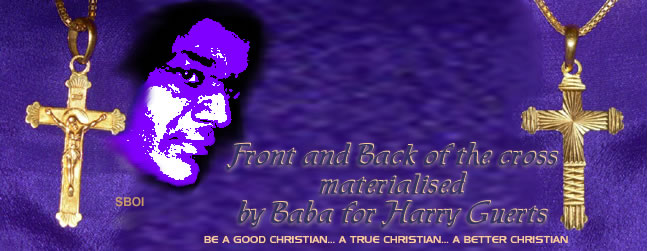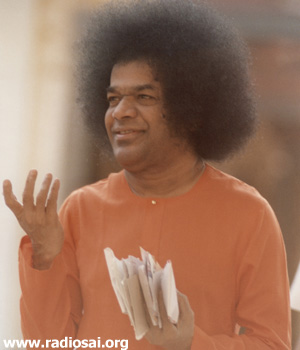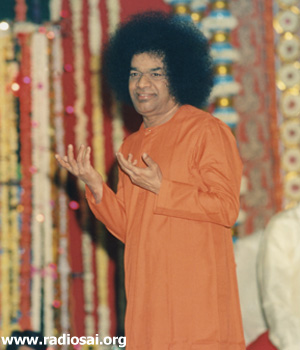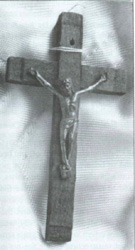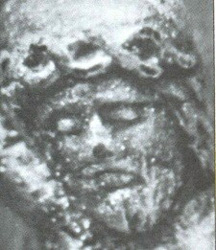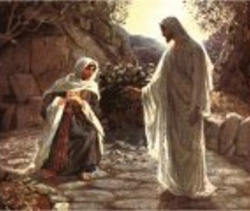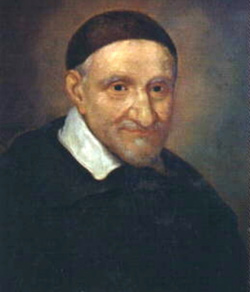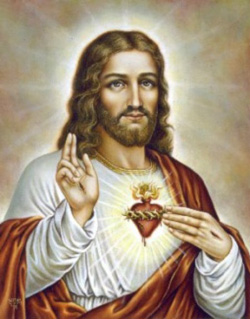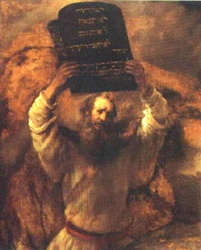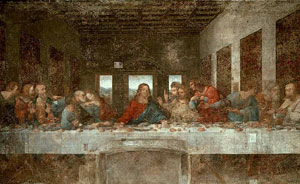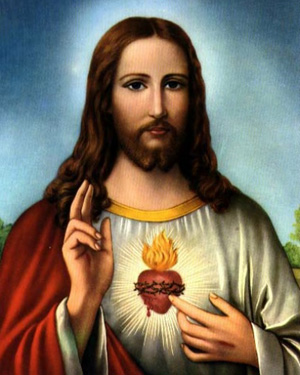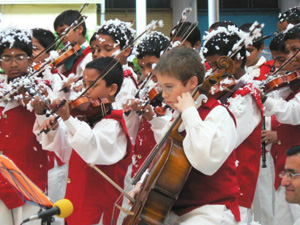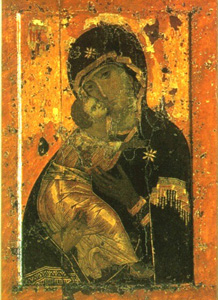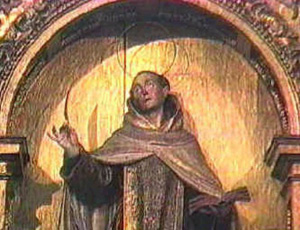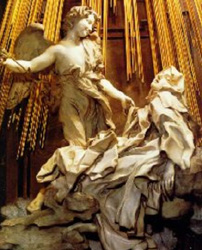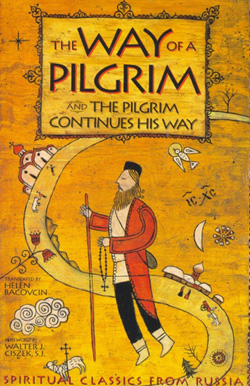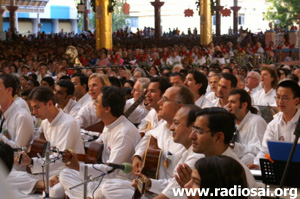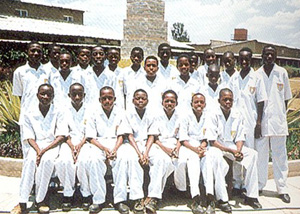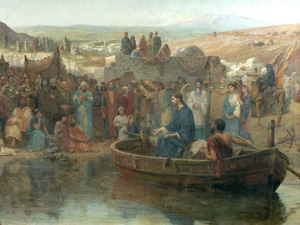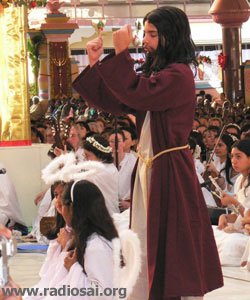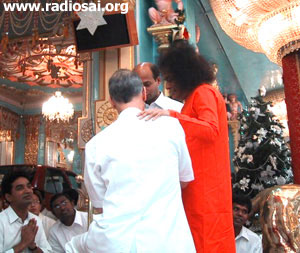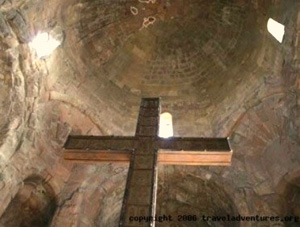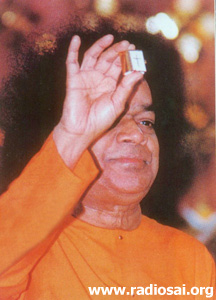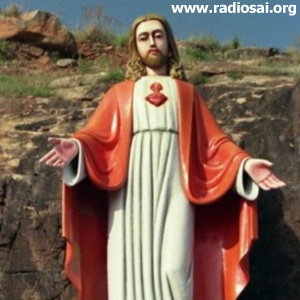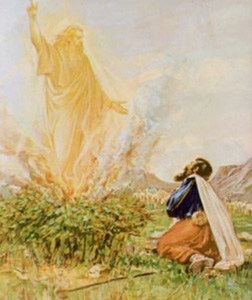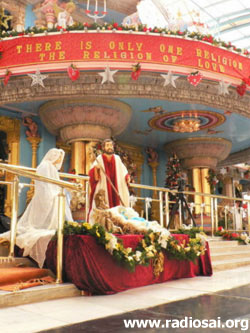|
BE A
GOOD CHRISTIAN… A TRUE CHRISTIAN… A BETTER CHRISTIAN
This is
the season in which Christians celebrate Easter – Jesus’ resurrection
from the dead after his crucifixion. What is the significance of this
celebration, not only for Christians but for all people everywhere?
How have the teachings of Sathya Sai Baba illuminated the meaning of
Jesus’ life, death, and resurrection in the lives of Christians who
have come to know him? These two questions have prompted this cover
story.
To fully
appreciate the story of Easter, we must start with the fact that Jesus
was born into the culture and religion of the Jewish people over 2,000
years ago. According to the first book in the Jewish Holy Scriptures,
humanity was originally created by God in a state of purity and
blissful intimacy with God:
Then God said, “Let us make man in
our image, in our likeness…” So God created man in his own image…
male and female he created them. God blessed them and said to them,
“Be fruitful and increase in number… I give you every seed-bearing
plant on the face of the whole earth and every tree that has fruit
with seed in it. They will be yours for food…” God saw all that he
had made, and it was very good
.
(Genesis 1:26-30)
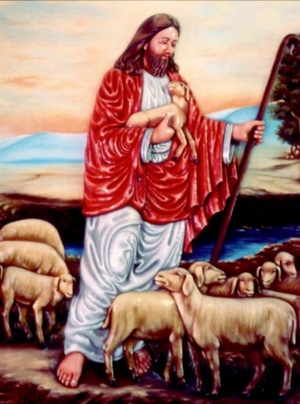 |
|
Jesus as the Good
Shepherd
|
|
Try to
be like Jesus. Jesus was a person whose only joy was
in spreading Divine love, offering Divine love,
receiving Divine love and living on Divine love.
Jesus was a supremely pure and sacred person.
(Sathya Sai Baba – 25 December
1979) |
|
|
|
This
state was known as “the Garden of Eden.” But man developed ego
and self-will, and “fell” from grace and purity and was sent
out of the Garden. God promised to send the Jewish people an
“Anointed One” (“Christ” in Greek or “Messiah” in Hebrew, the
language of the Jews) to save humanity from this plight.
Christians believe that Jesus was this “Anointed One”, the
“Christ” sent by God.
Since
the name “Jesus” is Greek for the Hebrew name Joshua, which
means “the Lord saves,” he became known as Jesus Christ – “the
anointed one who saves,” who would restore humanity to its
original state of purity and intimacy with God.
Jesus
was born of a virgin, Mary, in very humble surroundings near
their capital city of Jerusalem. He had a distinct mission,
which Sathya Sai Baba describes this way:
Jesus was to shatter the darkness that had
enveloped the world… to spread the light of love in the
heart of man and councils of humanity.
(24 December 1972)
In order
to carry out his redemptive mission, Jesus had to correct
mistaken ways of thinking, which he did through teachings such
as:
You have heard that it was
said, “Eye for eye, and tooth for tooth.” But I say to you,
Do not resist an evil person. If anyone strikes you on the
right cheek, turn to him the other also. You have heard that
it was said, “Love your neighbour and hate your enemy.” But
I tell you, Love your enemies and pray for those who
persecute you. (Matthew
5:38-39, 43-44)
|
|
Jesus gave
spiritual teachings and performed many miraculous healings for the
people of his time, as Sathya Sai Baba relates:
Jesus taught simple, practical
lessons in spiritual advancement for the good of mankind. He
manifested Divine powers to instil faith in the validity of his
teachings. He marked out the path that can confer on man the sweet
nectar of Divine bliss (ananda). He exhorted people by precept and
example to cultivate the virtues of charity, compassion,
forbearance, love and faith. These are not separate and distinct
qualities; they are only the many facets of the Divine in man, which
he has to recognise and develop.
(24 December 1972)
In the course of
his ministry and miracles, even raising people from the dead, certain
religious and political leaders felt challenged and threatened by
Jesus’ popularity. Sai Baba tells us:
Jesus was the epitome of compassion and the refuge of the poor,
needy and forlorn. But, many people tried to create troubles for
Jesus, since they did not like his sacred teachings and activities.
Their hatred for Jesus increased day by day. Even the priests turned
against Jesus as they became jealous of his growing popularity. Many
people out of jealousy laid obstacles in his path and even tried to
kill him. (25 December 2000)
Jesus foretold
what was to happen to him – that he would be crucified and then rise
from the dead on the third day. After three years of ministry, Jesus
was going to Jerusalem for an upcoming Jewish holy festival, the
Passover Feast, and a great crowd heard that he was coming:
They took palm branches and
went out to meet him shouting, “Blessed is he who comes in the name
of the Lord!”(John 12:13)
|
|
|
|
|
Cross
manifested by Sathya Sai Baba for John Hislop
|
Christ
sacrificed his life for the sake of those who put their
faith in him. He propagated the truth that service is God,
that sacrifice is God. Even if you falter in the adoration
of God, do not falter in the service of the living God. Be
ready to sacrifice even your life for the sake of God.
The spirit of
sacrifice is essential. To speak about devotion without a
spirit of sacrifice is meaningless. If the name of Jesus
is glorified all over the world today, it is because of
his boundless love. He served the lowly and the lost, and
in the end, he offered his life itself as a sacrifice
.
(Sathya Sai Baba – 25
December: 1970, 1998, 1993) |
|
|
On the Thursday evening before the Passover Feast, Jesus met
with his disciples for the Last Supper, knowing that the time
had come for him to undergo suffering on behalf of humanity’s
estrangement from God (going all the way back to the time of
the Garden of Eden).
That night, while praying in a garden, he was taken
into custody to appear before a Jewish tribunal and eventually
before the Roman ruling authorities of the region. Sathya Sai
Baba reports what happened:
Jesus’ critics complained to
the head priest against him. They tempted one of his
disciples with 30 silver pieces, to betray him into their
hands. The disciple who was most loved, Judas by name,
decided to work against the Master, yielding to the low
temptation of a few pieces of silver. Greed for money is a
demon that gets hold of the weak.
Jesus’ critics told
the Roman ruler that Jesus was attempting to assert himself
as king and so he should be punished for treason. The priest
knew that Jesus was speaking the truth, but he did not
support him in order to safeguard his own position. Their
insistences made the Governor order his crucifixion.
(25 December 1978, 23 November 1979, 25
December 2001)
|
|
On the next
afternoon, which was a Friday, Jesus was put to death by hanging on a
cross. (In the centuries to follow, Christians called this day Good
Friday.) Yet, he forgave all, even those who were nailing him to the
cross. As Sathya Sai Baba elaborates:
Jesus
wished well for those who insulted and injured him. He knew that God
wills all. So, even on the cross he bore no ill-will towards any one
and he exhorted those with him to treat all as instruments of God’s
Will. (25 December 1982)
|
On the following Sunday morning, his closest women disciples
came to his tomb, whose entrance had been sealed by a large,
round stone. When they arrived, the stone had been rolled away
and they were met by an angel dressed in a white robe, who
told them:
Do not be afraid, for I know
that you are looking for Jesus, who was crucified. He is not
here; he has risen, just as he said. (Matthew 28:5-6)
Jesus
had risen from the dead, on what later became known as Easter
morning.
The name
“Easter” comes from the name of a pagan goddess of Spring who
had been celebrated around the same time of year as the Jewish
Passover and the anniversary of Jesus’ resurrection.
Eventually, the early Christians borrowed that name to help
turn the pagan celebration into a Christian holiday.
Also read -
The Story of Easter, a supplement to the cover story.
|
|
| |
|
|
| |
Mary
recognises Jesus outside the Tomb
|
|
Jesus teaches
infinite love and compassion. To resurrect love and
compassion, you must kill jealousy and selfishness, and
purify your hearts. Speak sweetly; shed comfort with every
glance of yours. Do not be slaves to your sensual desires.
Dedicate your hand to the service of mankind. Earn the
true mercy of Jesus. Follow the path shown by him.
(25 December 1979) |
|
|
WHAT IS THE SIGNIFICANCE OF JESUS’ RESURRECTION FOR CHRISTIANS
AND FOR THOSE OF OTHER FAITHS?
For a Christian,
the resurrection of Jesus is essential to knowing that Jesus was
Divine and that his teachings were Divine. St. Paul – whom Sai Baba
said “was originally an inveterate critic of Jesus, (but) was
transformed by Christ’s love into the greatest apostle of Jesus and
the first propagator of the Christian faith” – stated the
importance of Jesus’ resurrection to Christians in a letter to an
early Christian community:
If Christ had not been raised from
the dead, our preaching is useless and so is your faith… (and) you
are still in your sins. But Christ has indeed been raised from the
dead. (1 Corinthians 15:15, 17, 20)
Sathya Sai Baba
gives a poignant understanding of the significance of this
“resurrection” and the lessons we can all learn from it, no matter
what our religion:
What is the resurrection, really? It
is the revelation of the divinity inherent in man. That is the
result of contact with the Godhead; that can come only after years
of contrition. Man is led into the wrong belief that the
accumulation of material possessions will endow him with joy and
calm. But Divine Love (Prema) alone can give that everlasting joy.
Divine Love alone will remove anger and envy and hatred. ( 28
February 1964 )
Jesus’ physical
resurrection points back to the early days of Jesus’ ministry when he
spoke of our need to be resurrected and reborn in a different
way – in the knowledge and direct experience of God:
I tell you the truth, no one can see
the kingdom of God unless he is born again. Flesh gives birth to
flesh, but the Spirit gives birth to spirit. (Jesus – John 3: 3, 6)
It is this same
“rebirth of spirit” that many Christians have experienced as a result
of coming to know Sathya Sai Baba. In fact, this rebirth of spirit has
been experienced by followers of all faiths as they have responded to
Sathya Sai Baba’s consistent urging that each of us should deepen our
faith and sincerely practise our chosen religion or spiritual path:
Each should practise his own
religion sincerely. A Christian should be a good Christian. A
Hindu should be a good Hindu. A Muslim should be a good Muslim.
Let each one be a true practitioner of his religion.
(14 April 1996)
A Muslim should become a
true Muslim. A Christian should become a true Christian. A Hindu
should become a true Hindu. You should have full faith in your
religion and lead an ideal life. (4 September 1998)
A Hindu should become a
better Hindu, a Christian a better Christian, a Muslim a better
Muslim. (19 November 1999)
|
|
|
“Be a good
Christian. Be a true Christian. Be a better Christian.” What does that
really mean in light of celebrating the resurrection of Jesus from the
dead after his crucifixion? Many people who were brought up in the
Christian religion have experienced a time when their beliefs faded in
importance in their lives, or they doubted and questioned what they
were taught in childhood. Many have felt a need to search for a deeper
understanding of what Jesus taught and how it applies to their lives
today.
We have
collected stories of eight men and women from Christian backgrounds
throughout the world, showing us how their knowledge and love of Jesus
Christ has been resurrected, reborn, or renewed
through their association with Sathya Sai Baba. They share with us how
they have discovered a closer relationship with Jesus, a more profound
appreciation of who Jesus was, and a deeper practice of what Jesus
taught. Each story brings to life teachings of Jesus that can apply to
us all, no matter what our faith might be.
Our first story
is from Harry Geurts, guest faculty member of Western music in the Sri
Sathya Sai Institute of Higher Learning since 1996, and previously
Vice President of the Sathya Sai Organisation in the Netherlands.
Growing up immersed in an atmosphere of Christian service, the
personal pain he experienced while contemplating Christ’s suffering on
the cross often overshadowed his celebration of Christ’s resurrection,
until he gained a profound insight from Sathya Sai Baba.
IN
GOD THERE IS NO SUFFERING
Harry Geurts – The
Netherlands
|
I grew up in a Roman Catholic family. People in my
grandfather’s generation had bought a building in Rotterdam
for the St. Vincentius Union (also known around the world as
the Society of St. Vincent de Paul), which gives many services
to the poor. I was born and grew up in that house and my
grandfather and father took care of the house.
I never
knew anything else. We had a big statue of St. Vincentius
there, and all I knew were people who were always talking
about Jesus. I went to church and learned to play the piano
there.
All of
my schooling was at Catholic schools with only boys. So I have
never gone to a school with girls. I have also only been in
choirs with boys and men, no girls or women. Even now I am
teaching here at the Sathya Sai Institute with only boys.
I have
always had a love for Jesus. Because I was active in the choir
and I was appointed to sing in the front, we always sang the
Christmas songs and all of the Jesus songs. The director of
the choir looked after us because we were the leading voices.
You cannot sing without love and there was always a loving
atmosphere – love was always in our singing. So the spiritual
foundation was laid.
When I
was 13, I started my own band. And when my voice broke, I left
the choir and that is when I came to the world. I had an idea
of becoming a priest before then, but then I saw so many nice
girls that I decided not to become a priest.
When I
was in my 20’s I became very depressed and disappointed by the
world, and I thought that Jesus must be in the world, but I
couldn’t see him. I was just beginning to peep into the world
at that time. I saw so many things and I thought, “Oh my God,
is this it?” So I was frightened, although my music profession
became my therapy.
During
the road of life, I got into my job and career and wanted to
make it, which I did both as a musician and an educator. I had
a nice house, nice car, and nice family.
In 1989,
I went to a healer and while I was sitting in the waiting room
I saw a photo of Swami. The lady pointed out to me that this
was Sathya Sai Baba, but I didn’t know anything. In 1992, I
came to know Sai Baba more as I began to read John Hislop’s
book, “My Baba and I.” Then, in 1994, I attended a session on
Sathya Sai education. I was very curious to meet devotees and
wanted to know what they were like. After coming to know many
of them a new world opened for me.
Even
though I had accomplished everything, I was not content and I
knew this was not the last thing I was to do in life. Then,
one thing after another happened, and one day in 1995 it all
collapsed, including my marriage.
I had
gotten so involved with my profession that I had no
relationship with Jesus and I forgot to be a human being. I
wasn’t a human being; I was a musician. So all of this was
necessary to get me back.
|
|
|
Inspired by Gospel values,
the Society of St. Vincent de Paul, a Catholic
organisation, leads women and men to join together to grow
spiritually by offering person-to-person service to those
who are needy and suffering in the tradition of its
founder, Blessed Frédéric Ozanam, and patron, St. Vincent
de Paul.
(Society of St. Vincent
de Paul)
All religions
and scriptures agree that going to the aid of
fellow-beings in times of need and saving them from
distressing situations is the greatest virtue of a person.
What Jesus preached was in accord with these basic
teachings of all religions. Seeing his acts of love and
kindness, people declared that he was a “messenger of
God.” Give happiness to those who are suffering and
consider every activity as God’s work .
(Sathya Sai Baba – 25 Dec
1982, 1996, 1998)
Wherever you
may be, go into the society and render social service in
all possible ways, with faith in God and in a selfless
spirit. The fulfilment of human life consists in the
service that man renders, without any thought of return,
in an attitude of selflessness. Service rendered in this
spirit sheds light in the dark interior of man; it widens
the heart and purifies the impulses and confers lasting
bliss (ananda).
(Sathya Sai Baba – 25 Dec
1970, 1989) |
|
|
One year after the big
collapse in my life, I received an invitation to go to India to play
in the symphony orchestra at the ashram during Gurupoornima in 1996.
|
|
|
|
|
Front and
Back of the cross materialised
by Baba for Harry Guerts
|
When Jesus
reached the stage of unity with God, he had no suffering
at all. He was blissful and was prepared for anything.
Even at the time of crucifixion, Jesus was smiling,
because he realised that he was not the body. Body is
bound to perish, but the in-dweller has no birth and
death. Truly speaking, the in-dweller is God Himself.
Jesus understood that his body was merely a vesture, and
that God was the in-dweller.
(Sathya Sai Baba – 25 December 1998)
God
takes upon Himself the pain and sorrow of the world in
order to prepare the hearts of men for love! But, when you
look at the truth squarely in the face, you will know that
in God there is no “suffering” and that you too have no
reason to suffer! The entire world is the play of love!
You suffer on account of love. It is love, love, right
through – there is no reason for sorrow or pain or
suffering!
( Sathya Sai Baba – 25 December
1970) |
|
|
This was the beginning of everything for me. Swami
was like mother and father for me. First like mother and then
later like father. He called me for interviews and spoke to me
and healed my leg.
I prayed to Swami to see Jesus as he was. One day he asked me
to give a talk, and after the talk he made a chain for me with
a cross. This signified to me a new start in my relationship
with Jesus.
Last year, the students asked me to participate in a
Good Friday programme, to talk about my experience with Jesus.
At that programme, I told about how I was always in tears as a
young boy during the week leading up to Jesus’ crucifixion.
On Good Friday, I was always in agony looking at my
watch, thinking about the time that Jesus died. I always died
somehow myself; it was terrible for me.
Even though Palm Sunday celebrations started joyously
and we were very happy as we gave fruit to all the elderly
houses, it would end in this very agonizing time on Good
Friday.
Then I told how in 1992, I had read in John Hislop’s
book where Swami said that Jesus did not suffer at the
crucifixion – and Swami said the same thing at Christmas in
1998.
I grew up with such agony around seeing Jesus on the
cross. I had no other view. And then Swami said that Jesus did
not suffer. It turned everything around for me and it took
time for me to really realise it, because it had been so
impressed on my mind.
I cannot describe my feeling; it is such an emotional
thing for me when I realised that Jesus did not suffer.
Yes, Jesus did take on the world karma in those days
and he died, but this is the same thing that Swami is doing
now. Swami knows what he is doing, just like Jesus knew when
he sent Judas away to betray him. |
|
I
concluded my short speech with a question to Swami, “Please Swami tell
us more about the life of Jesus.” I wasn’t expecting that he would
stand up and give a discourse, but I wanted to know more.
|
Months
later when I returned to the Netherlands I went to the Sai
Center and Luc Courtois let me know that the book he had
written about Swami’s teachings about Jesus had come out on
Good Friday.
I took
this book with me the next time I came to the ashram and read
it twice. I then presented it to Swami for His blessings and
he said, “Very, very happy.”
One
thing I have learned by being with Swami is how to calm myself
down when someone is against me. I can now take time to see
them with love, this is very important to me. I have a
tendency of wanting to overreact and argue back.
I now
see that there is really no enemy; the only enemy is myself.
Every person is just a mirror for us. To understand the love
that Swami and Jesus talk about takes time. So I am trying to
understand this love.
To see
Swami as the father of Jesus is to me the most logical thread
between Jesus and Swami. For me, Jesus has always been like a
friend. This is the same for me with Swami. Last year I felt
that Swami had become my friend. The moment I met Swami I
realised that His voice has always been there and has always
guided me in my life.
Sharing
Harry Geurt’s love for Jesus is Father Charles Ogada, a Roman
Catholic priest. For him, such love brings us all alive in our
oneness with God and with our neighbours.
During
an interview with Radio Sai’s host Dr. Venkataraman, Father
Ogada shared how his experiences with Sathya Sai Baba helped
him take his priestly vows more deeply, and to live a life of
intimacy with God.
|
|
| |
|
|
| |
Icon of Jesus and the
sacred heart
|
|
But I tell you who hear
me: Love your enemies, do good to those who hate you,
bless those who curse you, pray for those who mistreat
you. Do to others as you would have them do to you.
(Jesus – Luke 6:27-28, 31)
I have called you friends,
for everything I learned from my Father I have made known
to you.
(Jesus – John 15:15) |
|
|
LOVE GOD WITH ALL YOUR HEART
Father Charles Ogada
– Nigeria
I was
first introduced to Sathya Sai Baba by a priest who was a lecturer at
the seminary I was attending. He gave me the book “Sai Baba: the Man
of Miracles” by Howard Murphet to read. I wasn’t so struck by the
miracles themselves, but realised that they were signals to a higher
reality. To me that higher reality is the One that pervades all
things, God Himself, the unseen that is behind the seen. The miracles
are different, they are things in the hand, but there is a hand
holding it. This really pushed me into an inner inquiry about that
reality.
As a Catholic
priest I had thought about this before, but not in this context.
Before this it was an intellectual thinking; now it became a passion.
This was an eye-opening in my life – the fruit was ripe to fall. I was
really drawn into a search of inner inquiry about these realities.
In the Gospel of
Mark, chapter 12 verse 29, a young scribe who was a teacher of the
Jewish law came to Jesus and asked him a question, “What is the
greatest commandment?” Jesus looked at him and replied from the Old
Testament, “Listen Israel, the Lord your God is one, there is no
other. And you shall love the Lord your God with all your heart, with
all your soul, with all your mind, and with all your strength. There
is no other commandment greater than this.”
| |
|
|
| |
Moses and the 10
Commandments
|
|
Love the Lord your God
with all your heart and with all your soul and with all
your strength.
(Moses – Deuteronomy 6:5)
Love your neighbour as
yourself.
(Moses – Leviticus 19:18)
One of the Pharisees,
an expert in the law, tested him with this question:
Teacher, which is the greatest commandment in the Law?
Jesus replied: “Love the Lord your God with all your heart
and with all your soul and with all your mind. This is the
first and greatest commandment. And the second is like it:
Love your neighbour as yourself. All the Law and the
Prophets hang on these two commandments.”
(Jesus – Matthew 22:37-40)
The heart of Jesus was
pure and calm. Hence it is honoured as sacred. We must
make our hearts sacred so that either we merge in Jesus or
Jesus merges in us. When we merge, it is called devotion
(bhakti); to say Jesus awakened in us is the path of
wisdom (jnana).
( Sathya Sai Baba – 25
December 1984)
|
|
|
When I
came to Baba’s teachings, I discovered what this meant. For
example, the first call Jesus made was, “Listen Israel.” It
was a call to silence, to the sound of OM. The other one is
that the Lord is one; there is no other reality. All of the
other things are illusions; they are non-existent.
And to
love this One with all your heart, that is bhakti yoga, with
all your mind that is jnana yoga, and with all your strength
is karma yoga. And to love your neighbour as yourself is to
realise that the same Self in others is the same Self (Atma)
in you.
In one
of Baba’s Telegu poems from Sai Gems, he said,
“I am
telling you once and for all in one sentence: the one
quintessential teaching of all scriptures is that you should
firmly feel your identity with the One and the same Self
(Atma) that is present in all beings.”
This is
the same sermon that Jesus Christ gave to that young man who
asked him for a summary of all the scriptures.
I have
never had any doubts about the Divinity of Baba. It is because
I feel that my connection with Baba is not just this
incarnation; that I have come across him before. For me Baba
is love; that is how I know his Divinity. Love is unity; love
arises from the realization of oneness. The greatest oneness
is to realise the oneness with God. That is the greatest love.
One
experience with Baba that has really influenced me was during
my first interview. I am a Catholic priest and I belong to a
congregation where we take vows of poverty, chastity and
obedience.
I was
sitting in the general interview room and Baba called me aside
and whispered to me, “How are your wives?” I was taken aback
and thought, “Oh my God.” I said, “Baba I don’t have any
wives.” I then remained silent and he began talking to other
people.
After a
while he again asked me the same question. I kept quiet
because I knew he was up to something. Later on in a
subsequent interview he said to me, “Sometimes you want to
marry, sometimes you don’t want to marry. You are mine.”
My
experiences with Baba have made me live the life of intimacy
and to take the vows more deeply. For example, there is a lot
of talk about celibacy now. The problem is not with the
priests; the problem is that they are expected to live a life
without being taught how to live that life.
So life
is like a suppression for them. Baba teaches us how to
transform the lower energy into a higher energy so it becomes
a flow and you can begin to live life in full without thinking
that celibacy is a punishment. This experience has helped me
gradually step-by-step to move into a whole new view of life.
|
|
From my own
experiences with Baba, I have also learned that the meaning of the vow
of poverty we take is to act without ego. Poverty is being above
praise and blame, above success and failure, establishing yourself in
the equanimity of spirit. Because of Baba I can now live this kind of
life in full awareness.
|
There is
no contradiction for me between the teachings of Jesus Christ
and Baba. When I began to read the Bible in light of Swami’s
teachings, I found a lot of new meaning, a lot of things that
I never expected like these insights.
I
believe that there are so many problems in the world because
of ignorance, because of the lack of spiritual inquiry. We are
inquiring about the objective world, but not spirituality.
What
Africa needs now is Baba. The problems in Africa are not
poverty or wars; the problem in Africa is spirituality. When
we know God and we know that we are God and everyone else is
God, then all these wars and poverty will go.
When I
know that the same spirit is in others that I have within
myself, when I realise that oneness, then there is no room for
me to harm you.
Baba has
given us many practical steps to begin solving these problems
in Africa, like education. This is the greatest - taking the
young people and starting when they are small to train them in
the path of human values and spirituality.
Another part is that although the African man is a very
religious man, he still needs spiritual nourishment to satisfy
his hunger. Self-less service without any ego does this.
Just as Divine love brings about the experience of oneness
with God, it also awakens the awareness of the Divinity in one
and all. This was the discovery not only of Father Ogada, but
also Bernice Mead, National Coordinator of the “Education in
Human Values” programme in the USA. During her interview with
Dr. Venkataraman of Radio Sai, she tells us how, through
Sathya Sai Baba’s presence in her life, she transformed her
fundamentalist Christian background into a broad understanding
that we are all Divine.
|
|
| |
|
|
| |
Jesus with his twelve
disciples before His cruciflxion
|
|
And he took bread, gave
thanks and broke it, and gave it to them, saying, “This is
my body given for you; do this in remembrance of me.” In
the same way, after the supper he took the cup, saying,
“This cup is the new covenant in my blood, which is poured
out for you.”
(Jesus – Luke 22:19-20)
Jesus said that the
bread taken in the “last supper” was his flesh, and the
wine, his blood. He meant that all beings alive with flesh
and blood are to be treated as he himself and that no
distinction should be made of friend or foe, we or they.
Every body is his body, sustained by the bread; every drop
of blood flowing in the veins of every living being is
his, animated by the activity that the wine imparted to
it. That is to say, every man is Divine and has to be
revered as such.
( Sathya Sai Baba – 25 December
1978) |
|
|
YOU
ARE GOD, ALL ARE GOD
Bernice Mead – USA
I found out
about Swami in 1977 and made my first pilgrimage in 1978. I am a very
atypical devotee because I come from a large farm family in
mid-America with 11 children and was raised as a fundamentalist
Christian. When I met my husband he wasn’t interested in organised
religion and so we began to search for truth. We first went to more
liberated Christian churches but could not find what we were looking
for there. So we started taking meditation classes.
I had been
taught all my life that Jesus was the only way. And not only was Jesus
the only way, but the church that I attended was the only church. I
questioned this from the time I was a teenager. It seemed unreal to me
that everyone who loved God could not have a chance to be with God. So
I wanted to know the truth and what this was all about. Could it
possibly be that the little fundamentalist church I was going to was
the truth, the only truth?
| |
|
|
| |
A devotional painting
depicting the sacred heart of Jesus
|
|
I and the Father are
one. I am in My Father and you are in Me and I am in you.
(Jesus – John 10:30 ; 14:20 )
You are in God and God
is in you. Understand this truth and act accordingly. You
should be able to say with conviction that you are the
spark of the Divine. You should say with courage and
conviction that God is everywhere. You must fill yourself
with the feeling that God is in you, beside you, around
you, and with you wherever you go.
( Sathya Sai Baba – 15 Jan 2000, 25
Dec 1985) |
|
|
I had
just had my first child and I was going through post-partum
depression, so I was really searching for something besides
what I had. Eventually, I heard about a meeting to be held by
a man who had been to Sai Baba and who was going to tell about
his experiences.
I went
because my husband wanted to go, but I didn’t think that I
would hear anything of relevance. We were both captivated by
his stories, which were only telling about his experiences. We
spent the whole evening there. We smelled a sweet jasmine
right away; we thought it must have been incense, but it
wasn’t. When we left that evening around 11pm, we felt excited
and took three books with us. One of them was the “Holy Man
and the Psychiatrist” by Samuel Sandweiss.
I read
the book and right away I wanted to come to India. I felt so
drawn and so much in love with Sai Baba. I wanted to know who
he was and whether he was for real. Even though I am still
mystified by him, I love him dearly.
Back in
1978, coming to the ashram was very difficult. The weather was
hot and humid, the food was bothering me, and there were 14 of
us in the flat that I stayed in. I still had a lot of doubts
and there was a time when I wasn’t sure if I was in the right
place.
Swami
called all of the Westerners into the mandir and gave us a
discourse. Then he came around and gave each of us little
packets of vibhuti. I said to him, “Thank you.” That afternoon
I wrote him a letter and went early to darshan so I could get
the first row. He came and took my letter and said, “Thank
you” to me. So my first words to him were thank you and his
first words to me were thank you in return. This made me very
happy.
During
my second trip in 1979, I had to go alone after all of my
friends had come home. One morning while sitting under his
window where he lived in the mandir at the time, I had this
thought, “What if he isn’t who he says he is? What if he is
the anti-Christ?” I didn’t know where these thoughts were
coming from because I had been so happy and so thrilled at
being there. |
|
I got up and
went back to my room where I wept and wept. While I was there I prayed
very hard, I prayed to this God that I had prayed to all my life,
somewhere out there in space. I decided that I should also pray to
Jesus and so I brought Jesus into the prayer also. When I went to
darshan, Swami called me for an interview, which was a fulfilment of
my dream. He talked to me about all of the doubts I had had in my mind
that morning.
There was a part of me that knew that he knew all that I was
experiencing – but to experience that was another thing. He said to
me, “I hear all of the prayers, I even hear the prayers to Jesus.” So
I knew that he was telling me that he had been with me that morning
and knew that I had prayed to Jesus. Then he made me candy. My earthly
father owned a grocery store and used to bring me candy when I was a
child. This was like my earthly father giving me something so I would
feel better. I had been crying all morning, and I was like a child at
his feet, so captivated and so much in love.
|
The one
lesson of Swami’s that I find most important is that we are
God, we are all God. Elsie Cowan was a very good friend of
mine and she used to say all the time, “You are God. You are
God. You are no different than God.” And God is love, so love
and God are synonymous. To me this is the richest and the best
teaching.
I have
had wonderful experiences with children where I have learned
the lesson that we are all God. When I taught kindergarten
with six-year-old children we would have a few minutes each
day of quiet time.
One day
a sweet little boy wanted to share what he had experienced
that day during the quiet time. He said, “I saw God.” I asked
him if he could tell us what God looked like and he said,
“Yes, yes” and he put his hands over his head and said, “He
had a lot of black hair and a blue business suit.”
One day
while I was walking in a park, a little five-year-old came up
to me on his bicycle and said, “Please go home with me I want
you to meet my parents.” He kept asking me to go home with him
so I could meet his parents.
I didn’t
know this boy, he just came out of the blue while I was on my
afternoon walk. I told him, “I can’t go home with you today,
but I’ll come this way tomorrow and I promise I’ll go home
with you tomorrow.”
But he
kept begging me, “Please, oh please.” He was such a cute
little mischievous kid, so I said to him, “Say, do you know
Baba?” I don’t even know why I said this; it was out of the
blue. He jumped off of his bicycle and said, “Yes, I do! He’s
Jesus Christ and all his angels!” He got back on his bicycle
and rode off and I never saw him again.
I am the
national coordinator of the EHV programme in the USA , and I
travel through the states giving teacher training classes.
In 1979
I started one of the first Bal Vikas children’s classes in
southern California. We would sing a lot of songs and began to
learn bhajans.
We all
learned and grew together. One time I had a little boy who was
quite precocious and he gave his school teachers difficulty in
the classroom. After he had attended Bal Vikas for a year, his
school teacher told me, “I don’t know what you’re doing, but
whatever you are doing, keep it up. I have seen such a
wonderful change in this child this year.” |
|
| |
|
|
| |
Christmas morning
concert at Prasanthi Nilayam
|
|
Let the little children
come to me, and do not hinder them, for the kingdom of
heaven belongs to such as these.
(Jesus – Matthew 19:14)
Unless you change and
become like little children, you will never enter the
kingdom of heaven. Therefore, whoever humbles himself like
this child is the greatest in the kingdom of heaven.
(Jesus – Matthew 18:3-4)
You must take shelter in
the Divine principle to escape from the storms of life.
You will be welcomed by the Divine only when, as Jesus
said, you become like a child. They have the sense of
wonder, fresh and free; they have the simple, sincere
eagerness to know; they have reverence towards knowledge
and power. Christ treated the children with tenderness,
and advised all the grownups to become like children, so
that they may be saved.
(Sathya Sai Baba – 23 May 1967, 22
Nov 1969,
23 April 1967) |
|
|
These are the
kinds of experiences I have had with children where for some moment in
time they knew. God has had wonderful fun with me through children.
Through
children, God revealed to Bernice many new insights about the nature
of God. But William Miller – guest faculty member in the Sri Sathya
Sai Institute of Higher Learning’s MBA programme since 1999, and
co-author of Human Values at Work – had to transcend some
deeply in-grained childhood beliefs in order to “see the Light” and
“be the Light.”
I AM IN THE
LIGHT, THE LIGHT IS IN ME, I AND THE LIGHT ARE ONE
William Miller – USA
|
As
I look back on my upbringing, I was “very Roman
Catholic” – even co-president of my parish’s teen youth
organisation when I was 17.
I
was disciplined and respectful in my relations with girls and
elders – wanting to be known as a good person, and to me the
ten commandments were the perfect “measuring stick” to
determine if I was being good. I particularly strived to be a
peaceful person, not ever wanting to hurt anyone.
But this
determination did not come from a positive love for God and
others; rather it was based in a self-dislike and
self-criticism which I wanted to overcome.
My
experience of life and being a Christian was coloured by a
strong belief that my nature, particularly as a male, was
“selfish, hedonistic, and environmentally destructive” – and
that my job as a Christian was to overcome my nature.
God was “out there” or “up there” – distant, judging,
punishing, loving you only if you were good.
After
going to college in the mid 1960’s, I found myself becoming
“agnostic”, neither believing nor disbelieving in God. I just
didn’t know. While I enjoyed being with friends and the priest
at my university’s Catholic centre, I fell away from the
Catholic religion.
I felt
attracted to Zen Buddhism as a practical “substitute” to
nurture my inner growth, particularly as author Alan Watts
introduced it to the West. In fact, it was his book “Myth and
Ritual in Christianity” that first renewed my appreciation for
the spirit of Jesus’ teachings. In 1982, a deeper level of
spirituality began to stir within me.
I found
myself saying the word “Divine” without consciously thinking
about it ahead of time. A new joy began to well up inside of
me and I would make up little songs such as “Divine love,
expressing through me, always draws to me all that I need.”
The
night just before Easter Sunday that year, I “accidentally”
(are there any coincidences or accidents?) came across a film
on TV called “The Lost Years of Jesus”, produced by Richard
Bock.
I
watched the entire film, but when near the end it showed this
Indian guru named Sathya Sai Baba, I paid little attention.
Only later did I realise that Easter weekend was my first
semi-aware contact with Baba.
Later
that year, a good friend was reading “Man of Miracles” by
Howard Murphet, chronicling many early experiences with Sai
Baba. I had never ever sought an India spiritual teacher, but
I asked to borrow the book.
|
|
| |
|
|
| |
Mother Mary and Jesus
"Tender Loving Kindness"Icon
|
|
There was a huge halo of
splendour illuminating the sky over the village when
Christ was born. This meant that he who was to overcome
the darkness of evil and ignorance, had taken birth and
that he will spread the light of love in the heart of man
and councils of humanity.
( Sathya Sai Baba – 24 December
1972)
When we read the Bible,
we look at Christ as an ideal figure who proclaimed truth
to the world. The moment the story of Christ’s birth to
the Virgin Mary is revealed, all those who follow
Christianity rightly feel very proud, and feel that this
mysterious birth is the result of some Divine power and
that Mary was a very sacred woman.
( Sathya Sai Baba – Summer Showers
1974)
Like the fragrance in
the bud of a flower, Jesus’ Divinity was evident from his
boyhood. …Jesus displayed such sacred qualities as
compassion, love and sacrifice. The inspiration for this
came from his mother Mary, who taught him such good
qualities as truth, kindness, compassion and justice.
( Sathya Sai Baba – 25 December:
1991, 1994) |
|
|
Halfway through
reading it, I thought, “This is very, very difficult to
believe, that such a person is walking the earth – but if it’s
true, I don’t want to look back in 40 years and say that I missed
my chance!” I knew inside that I should go see for myself, and I
travelled to India seven weeks later.
My first day at
Prasanthi Nilayam was the last day of a ten-day festival called
Dasara. At one point during the morning function, Sai Baba went around
and sprinkled everyone with blessed, holy water. I thought, “As a
Catholic, this is very familiar” and I felt more at home. Then he gave
a discourse.
|
I could
understand very little of the translation into English, given
the interpreter's different accent, but a few words rang
crystal clear – they were the words I most needed to hear:
“When you realise that God is inside you, then the more you go
into yourself, the closer to God you become… and the distance
between your will and God’s will likewise begins to diminish.”
When the
discourse was over, I walked out of the auditorium stunned and
dizzy – I actually had to lean against a tree. While I had
been slowly rooting out of my psyche the childhood belief that
God was distant and my very nature was sinful, Sai Baba’s
words were like the hammer blow that finally split the rock. I
had been opened up, healed, and reborn onto a spiritual path
that ultimately led me back to a new relationship with Jesus
and Christianity.
Ever
since I was a 13-year-old attending the Catholic Jesuit High
School, I participated once a year in some kind of spiritual
retreat. In college and afterwards, these retreats took the
form of “human potential” seminars. Now, I made India my
annual retreat. I could tell right away that being around
Sathya Sai Baba would be the most nourishing way I could find
to grow spiritually.
Each
year when I would come for 10 to 14 days, on my annual work
vacation, I would select a book to bring as my core spiritual
reading. In the mid-1980’s, I read the books of two 16th
century Spanish Christian mystics: St. Teresa of Avila and St.
John of the Cross. Both spoke about the “marriage” of the soul
with God, and that the fundamental message of Jesus was the
path of Divine love.
The
hours waiting for Sai Baba to emerge from his residence to
give Darshan were often exquisite times for me to
ponder and pursue a new understanding of who Jesus was –
through the experience of these two saints who devoted their
entire lives to love and know Jesus, and to follow the path he
laid down for us.
Sai Baba
often spoke of three stages of spiritual growth: “I am in the
Light,” “The Light is in Me,” and “I and the Light are One.”
St. John of the Cross spoke of spiritual growth in terms of
putting a log on a fire: at first, the fire has to heat up the
log; then the log begins to emit flames, but only with the
helpful heat of the coals; finally, the log is fully ablaze so
that there is no distinguishing the “log” from the rest of the
fire. I saw that Sai Baba and St. John of the Cross were
describing the same three stages. And when Sai Baba explained
how Jesus’ life showed us these same stages – as “Messenger of
God,” “Son of God,” and “I and the Father are One” – my faith
grew that Jesus really could be a model to inspire and guide
my spiritual growth. |
|
| |
|
|
| |
Statue of John of the
Cross in a chapel in
Fontiveros, Spain
|
|
When Jesus proclaimed
that he was the messenger of God, he also wanted to
emphasise that everyone is a messenger of God and has to
speak, act and think like one. This is the true spiritual
discipline of selfless work, prayer, service to humanity
and meditation.
( Sathya Sai Baba – 25 December
1978)
When spiritual progress
is furthered Jesus asserted that each one can recognise
all as sons of God, children of God, brothers and sisters
of oneself. When you lead a life of purity and morality,
you are entitled to regard yourselves as “sons of God.”
God is the embodiment of love and you should not do
anything that is contrary to the love that God represents.
( Sathya Sai Baba – 25 December 1978, 1984)
Finally, when knowledge ripens into
wisdom and the goal of spiritual wisdom is reached, each
one realises, “I and my Father are one,” just as Jesus
ultimately declared. Jesus and his Father were one. You
and God are also one and you can be aware of it. You must
take note of this oneness. You must proclaim your oneness
and not your diversity.
(Baba – 25 December: 1978,
1997,1984) |
|
|
Later, when I
read, as if for the first time, Jesus saying, “I am in the Father and
you are in Me and I am in You,” I directly experienced that I could
travel the pathway with Jesus through these stages, ultimately ending
with knowing our union with God. Thus, for me, Jesus’ life and
teachings, and the life and teachings of Sai Baba, became mirror
reflections of each other. And when I read Jesus’ words about a
baptism by fire – “I have come to cast fire upon the earth, and how I
wish that it were already kindled! I have a baptism with which to be
baptised, and how greatly and sorely I am urged on until it is
accomplished!”— I could rejoice, rather than be afraid, that this
baptism of fire would ultimately turn this William-log into a heart
ablaze with Divine love.
However,
the idea that this journey could end with the experience that “God and
I are one” – was quite difficult for me to “warm up to.” My upbringing
said that this was blasphemy, the statement of an ego-out-of-control.
But then, Sai Baba led me back to my Christian tradition where “union
with God” was the ultimate aim of every mystic.
|
Jesus:
…that
all of them may be one, Father, just as you are in me and I am
in you. I have given the glory that you gave me, that they may
be one as we are one.
(John 17:21, 23)
St. Paul : He who unites himself with the
Lord is one with him in spirit. (1 Corinthians
6:17)
St. John : God is love. Whoever lives in
love lives in God, and God in him. (1 John 4:16)
St. Teresa of Avila : The Lord appears in the centre
of the soul, not in an imaginative vision… One can say no more
than that the soul, I mean the spirit, is made one with God.
|
|
|
|
|
Maximus the Confessor:
When a
human being gives himself entirely to God’s love and is
united with him by grace, he penetrates entirely into God
and becomes God, without losing his identity.
Angelius of Silesius:
Fire melts and makes One; if you
rejoin Origin, your spirit with God’s will be melted in
One.
St. Catherine of Genoa: I am so… submerged
in His immense love… my being is God, not by simple
participation, but by a true transformation of my being!
My Me is God, nor do I recognise any other Me except my
God Himself.
Meister
Eckhart: God
gives birth to the Son as you, as me, as each one of us.
As many beings – as many gods in God. In my soul, God
not only gives birth to me as his son, he gives birth to
me as himself, and himself in me. I find this divine
birth that God and I are the same... Here, in my own
soul, the greatest of all miracles has taken place – God
has returned to God!
|
|
|
A sculpture of the ecstasy
of St.Teresa of Avila
|
|
|
|
I also
began to see how other teachings of Sai Baba were alive and well in
the Christian tradition. For example, he has often said that the most
effective means of spiritual growth is repetition or singing of the
names of God, thus promoting a continuous awareness of God’s presence.
When I
read the book, “Way of a Pilgrim” – written in the late 1800’s by a
Russian who constantly recited the “Jesus Prayer” (“Lord Jesus Christ,
have mercy on me”) – I could only smile in recognition of what Sai
Baba’s advice could mean for a Christian.
|
Yet all
of this has been just the beginning. My journey with Sai Baba
and Jesus, which started (at least in my own awareness) one
Easter weekend in 1982, continues forward – my own version of
what it means to experience “heaven on earth.”
Just as
William had to overcome early childhood beliefs, in order to
love Jesus and himself, Sylvia Alden – choir director for the
Prasanthi Christmas adult choir – struggled with beliefs about
Jesus that she was taught as a child. She had a healing
experience of Divine love in the presence of Sathya Sai Baba
that helped her understand how she could live a Christ-like
life.
GOD IS
PURE LOVE
Sylvia Alden
– USA
I
was brought up on a farm in the mid-western part of the United
States during the time after the Great Depression and that
which preceded the Second World War. Many were struggling to
recover from the depression and the fear of the war was strong
in our rural community.
My
maternal grandparents became born-again Christians and my
paternal grandfather was a Congregational minister. Their
concept of Jesus, and by extension of God, was of Divine
beings one could never expect to please. One could only fear
and obey. Love was not emphasised.
As a
child, these grandparents and their religious beliefs had a
marked and indelible impression on me. My parents also
followed these teachings and I wanted very much to please them
all. Somehow, I always fell short of the mark.
Jesus
became someone who knew everything I did and was marking it
down so that come the Day of Judgment, he could tell God all
the bad things I had done.
As I was
not the most perfectly behaved child, Jesus had a lot on his
list. He became someone to fear and dislike. I wondered how
Jesus could be so wonderful if he would tell on a little kid.
As part
of the religious training that was given to me by my parents
and grandparents, I was taught that unless one became a
born-again Christian one would be condemned to hell’s fire and
damnation for all of eternity. There was no other choice. |
|
|
The prayer of the heart
provided me with such delights that I doubted if there
were anyone happier than I on earth. …all that was around
me appeared to me in a delightful form, and all prompted
me to love God and to thank him – people, trees, plants,
animals, everything was akin to me. On all, I found the
impress of the name of Jesus Christ.
(The Way of a Pilgrim)
There can be no better
panacea for our suffering than chanting the Lord's name (“namasmarana”).
No greater or more potent weapon can even be there to help
man surmount his obstacles. When the mind is engaged in
the recital of God's Glory and the names of God, there can
be no temptation to stray into the rake's highway of
insane desire. It will be of considerable help to
establish the feeling of the constant presence of God,
within you and without. Let each and every cell of your
body be filled with His Divine Name. Nothing else can give
you the bliss, courage, and strength that you derive from
namasmarana.
(Sathya Sai Baba – 16 May 2002, 19
Oct 1969,14 April 2002) |
|
|
It was
extremely confusing to me that the same Jesus who was held up to love
people so much that he was willing to be crucified would also condemn
those who had never even heard his name. As I reached my teenage
years, I struggled to put these teachings into some semblance of logic
that I could fully accept. I went to church, sang in the choir, read
my Bible, and acted “as if” I truly believed the sermons I heard. The
one positive was the music.
|
I loved
the hymns that spoke of the love and glory of God. I drew
comfort from the music. I convinced others that I was a good
Christian. I felt like a hypocrite because my actions were lip
service only.
My
actions were just for show. I still could not accept the idea
that a person who loved Buddha or some other form of God would
be headed for hell.
When I
married and had children, I was firm in the conviction that my
children would not grow up in fear of God. I wanted them to be
free of the judgment of the beliefs of others. I doubted that
if God/Jesus existed, they really cared what we did. Why else
would babies die, people fight in wars, and good people
suffer?
As much
as I attempted to push God to the back of the closet, He
refused to stay there. He showed Himself to me in music and
nature.
I loved
nature in all its many forms and music was my healing place.
The yearning for the Supreme Being that created this beautiful
universe and populated it with people of such diversity and
beauty grew.
I was
searching for what would ring as truth within my heart, a
truth that I could share with my children which would allow
them to love others irrespective of their religious
convictions.
I began
to study Eastern religions, starting with the teachings of
Aurobindo. His teachings touched a place within that caused
the door of my heart to crack open a bit.
I first
heard of Sri Sathya Sai Baba in 1972. “Nice,” I thought.
“There is another saint like Aurobindo.” I continued to read
and study the wisdom of many Indian saints. Peace was growing
in my heart. I studied meditation and even had the temerity to
teach meditation classes.
In 1978,
I made my first journey to the Beloved Divine Feet of Swami.
He looked at me and I knew that He knew everything I had ever
said or done, would ever say or do.
And
miracle of all miracles, He loved me. He was all that I had
ever thought God should or could be – love, pure love. There
would never be condemnation or exclusion from Him.
My heart
was full to overflowing. God was here on this earth and I had
seen Him, talked with Him, felt His touch and I was free from
fear and doubt. Joy is too small of a word or concept to
express my feelings. I was truly home.
Swami’s teachings are
universal. They allowed me to look more objectively at the
teachings of the Christian religion. His discourses on the
life of Jesus brought the real Jesus to life for me. I could
now read the Bible with an openness that was lacking before.
The actual sayings of
Jesus reflected Swami’s words. I sang the hymns and drew
great joy and comfort, especially when I knew that those
words were describing my Dearest Lord.
|
|
| |
|
|
| |
Baba blessing the
Christmas adult choir programme with Sylvia Alden
|
|
Sai
Baba says that Divine love has three qualities –
changeless, selfless, and fearless:
Love knows only to give, not
to receive. Love does not seek anything in return. Such
Love is free from fear. These are the basic features of
true Love.
( Sathya Sai Baba – 12 July 1988)
Jesus exemplified these three qualities of Divine love
throughout his life…
Changeless :
Love your enemies and pray
for those who persecute you, that you may be sons of your
Father in heaven. He causes his sun to rise on the evil
and the good, and sends rain on the righteous and the
unrighteous.
(Jesus – Matthew 5:44)
Selfless :
I am among you as one who
serves. Whoever wants to become great among you must be
your servant.
(Jesus – Luke 22:27 and Matthew
20:26 -27)
Fearless :
Greater love has no one
than this, that he lay down his life for his friends.
(Jesus – John 15:13) |
|
|
I no longer closed my mind to the tenets of Christianity. Rather, my
understanding of Christianity was enlarged to be defined as living a
Christ-like life. Jesus lived a life of love, forgiveness and
complete surrender to God. I now realise that those who condemn
others’ beliefs don’t really reflect the teachings of Jesus.
| |
|
|
| |
Christmas choir at
Prasanthi Nilayam
|
|
You should sing God's
name with love. You will see the manifestation of Divinity
with your physical eyes when you sing His glory with all
love. Many noble souls merged in God through love.
It is the tongue that
tastes the delicacy and it is the heart that tastes love.
The taste of love is peerless. It is sweeter than even
nectar. Love alone can match love. God is love, love is
God. Live in love. Whatever you sing, sing with love. God
sees your feelings, not the rhythm or tune. If your
feelings are pure, God will take care of everything.
Scatter the seeds of
Love in dreary, desert hearts. Then, sprouts of Love will
make wastes green with joy, blossoms of Love will make the
air fragrant, rivers of Love will murmur along the
valleys, and every bird, beast, and child will sing the
song of Love.
Emerge from devotional
singing with a greater measure of Love!
(Sathya Sai Baba – 14 Mar 1999 , 14
April 1999,
4 october 1970 , 23 July 1971)
|
|
|
The love
that Swami embodies and showers on us all allowed me to
revisit my early upbringing. I came to realise that the
God/Jesus that I had feared and denied was nothing but the
extension of my family’s fear and their need to make sense of
a world that was lacking love.
Further,
their love for me took the form of needing me to be like them,
to believe like them and to ensure my going to heaven with
them. They didn’t want me to burn in hell for eternity.
When I
could look at their beliefs from this perspective, I was able
to understand them and their actions. My fear and distrust of
Jesus receded. My family continued in their beliefs and saw my
love for Swami as an indication that I was certainly on my way
to hell.
I felt
sorry that they were not able to see what I saw in Him. I had
felt pure selfless love the likes of which I could not have
imagined. It saddened me that they were not able to join me in
this glorious journey.
I don’t
just believe any more – I know that our Beloved Bhagawan is
indeed the Father of Jesus as He is the father and mother of
all. I also know that since the passing of my parents and
grandparents, they will have had the opportunity to see and
know Swami as I see and know Him as the embodiment of total
love and compassion, the supreme one who created and sustains
all. This brings me great comfort and allows me to let go of
the sadness that was a large part of my younger life.
What
relationship do I have with Jesus now? I see him as an older
brother who exemplified complete surrender to God. I look at
his dedication to God and am humbled. I no longer think he
will give God a list of my misdeeds.
I am
grateful that Jesus taught and lived the way of love. I am
comfortable with the understanding that for some people Jesus
is the only way, just as I am comfortable with the
understanding that there is a religion that is suitable for
all at whatever stage of spiritual life they may be. My
perception of Jesus and what he exemplified has freed me – by
his example of unconditional love and obedience – to
completely open my heart to his father. |
|
I offer my
complete gratitude and overwhelming love to Bhagawan Sri Sathya Sai
Baba, my dearest and most beloved Swami. He has given me a life
sweeter than I could have ever dreamed of. By His Grace, He is truly
my very best friend.
Sylvia
experienced a breakthrough in her life, but it was one she had been
seeking since her teenage years. For Victor Kanu, co-founder of The
African Institute of Sathya Sai Education, the breakthrough came much
more as a surprise. During his interview with Radio Sai, hosted by Dr.
Venkataraman, Victor tells how Sathya Sai Baba transformed his life
into one of selfless service, just as Jesus taught his disciples.
HANDS THAT HELP
ARE HOLIER THAN LIPS THAN PRAY
Victor Kanu – Zambia
I started my
career as a schoolteacher and headmaster of a large Roman Catholic
Primary school in Lunsa, Sierra Leone, before proceeding to Oxford
University in England for further studies in philosophy, politics and
economics. After that I became my country’s High Commissioner to the
United Kingdom. It was after that that I came in contact with Bhagavan
Sri Sathya Sai Baba in a miraculous way. This was in 1975.
I was
living a very high life, being a High Commissioner; the booze was a
regular thing. In a dream two angels took me to an unknown place which
I later discovered to be Prasanthi Nilayam itself. They left me at the
main gate of the ashram, where I met all of the religions of the world
including my African ancestors. When I woke up, of course it brought
about a tremendous change in me that I could not explain how or why it
happened. The things I used to do, like going to the parlour and
smoking, gradually faded away. This is how Baba first called me. This
was an extraordinary turning point in my life and also a
transformation point.
|
I
began to take spiritual matters rather seriously. Even though
I had been brought up as a Christian I had stopped going to
church. But after this experience I began going to church and
reading the Bible. And I became interested in Western
philosophy.
I have
never seen a contradiction in going to my Christian church and
following Sathya Sai Baba. In fact, the more I came to know
Baba, the better I became as a Christian. I gradually loved
Jesus Christ more so than ever before and I understood the
Bible more so as a result of my contact with Baba.
Although
Baba has immense power and immense influence, he tells people
to stay where they are, be a good Christian, be a good Muslim.
This is in agreement with his teachings that there is only one
religion, the religion of love. He says he has come to water
the roots of all religions, not to uproot them, but to freshen
them up.
When I
finished my job as High Commissioner, Mrs. Kanu and I engaged
ourselves in teaching with the Inner London Education
Authority. This is what brought about our active contact with
Sathya Sai Baba. In 1980 we came to Puttaparthi to attend the
first overseas Bal Vikas teachers training course; we were
among the first to be trained on Swami’s “Education in Human
Values” (EHV) programme. It was an eye-opener after that
course. We liked the programme so much that we felt this was
the answer for Africa. So we started implementing it in the
London schools and gradually our interest in returning back to
Africa grew. We saw that this was the programme that could
transform, unite and also integrate Africa.
|
|
| |
|
|
| |
The Miracle School -
Sathya Sai School
in Ndola, Zambia
|
|
Now a man came up to
Jesus and asked, “Teacher, what good thing must I do to
get eternal life?” If you want to enter life, obey the
commandments. “All these I have kept,” the young man said.
“What do I still lack?” Jesus answered, “If you want to be
perfect, go, sell your possessions and give to the poor,
and you will have treasure in heaven. Then come, follow
me.” When the young man heard this, he went away sad,
because he had great wealth.
(Jesus – Matthew 19: 16-17, 20-22) |
|
|
We had visited Zambia very
briefly to conduct a workshop; that was all. We knew no one there
except a few devotees. When we came to Baba in 1987, he placed his
hands on our heads and said, “Go to Zambia and spread my message of
love. Build a school. Spread my message through education and help the
people.” So it was Baba who chose Zambia for us.
| |
|
|
| |
Mother Teresa (1910 -
1997)
|
|
“Lord, when did we see
you hungry and feed you, or thirsty and give you something
to drink? When did we see you sick or in prison and go to
visit you?” I will tell you the truth, whatever you did
for one of the least of these brothers of mine, you did
for me.
(Jesus – Matthew 25:37, 39-40)
“We all long for heaven
where God is, but we have it in our power to be in heaven
with Him at this very moment. But being happy with Him now
means: loving as He loves, helping as He helps, giving as
He gives, serving as He serves, rescuing as He rescues,
being with Him 24 hours, touching Him in his distressing
disguise. ”
(Mother Teresa)
In the Bible, it is
recorded that Jesus washed the feet of his disciples. When
they asked him why he was doing so, Jesus answered: “I am
washing your feet as your servant, so that you may learn
to serve the world.” Love must be manifested as service to
others and that service must take the form of food for the
hungry, solace for the forlorn, and consolation for the
sick and the suffering. Jesus wore himself out in such
service to humanity.
(Sathya Sai Baba – 25 Dec
1984, 1981) |
|
|
I
remember during that interview that my wife was brave enough
to ask Baba, “How about funding?” Swami said sell your house;
if that is not enough borrow from the banks. We were delighted
when he said this to us.
Being brought up as Christians, we remembered the story in the
Bible where a rich man went to Jesus and said, “Oh Lord I’ve
done this and I’ve done that, what else can I do to enter into
the kingdom of God?” And Jesus said, “Sell all that you have
and give it to the poor and follow me.” After Jesus said that,
the man ran away.
We
didn’t want to run away. We were so thrilled that Sathya Sai
Baba, whom we believed to be God incarnate, gave us this test
and we did exactly what he told us to do.
We were
not afraid at all. The country was new to us. But we
remembered the stories of other disciples who had gone to
distant lands, the Lord was with them and that was all we
needed. We knew that Baba was with us throughout.
When he
told us to go to Zambia, he did not tell us we would not face
difficulties. Difficulties are a part of life and when you are
doing God’s work you face even more difficulties and more
tests. We enjoyed every bit of them; we knew this was the Lord
testing us.
Our
school in Zambia is called a “Miracle School”, first because
of its location. The school is in a disadvantaged area of
Ndola with very poor infrastructure, very poor roads. We could
have built it in the middle of the city, but I sent Mrs. Kanu
to ask Baba where to build it and he said to go to a poor area
and start with a boy’s school. We started the primary school
and collected the dropouts as our first students.
This was
all part of the Divine plan. When these students took their
first national tests, they had top scores. The nation was
stunned. How can a school that is located in a village among
poor children do so well?
This was
the first time in the education of Zambia that they had ever
experienced this. So their results were outstanding, their
character improved, they became good boys in a short period of
time.
This
also made a tremendous impact on their families. In one
instance, a boy insisted that his father take him to school
early in the morning. After dropping the boy to school, the
father would report to work.
Within
six months the father got a promotion because he was now the
first person to show up for work. There was another man who
was a managing director who also dropped off his boy and
started going to the office early. The late attendance of his
employees reduced. |
|
There are so
many testimonies from the parents and from the children. There are
boys who never used to study who now began to tell the others to
study; they would give others’ advice. When we opened the school in
1992, there was only one family who could afford to bring their son in
a car, but after this our school started attracting good students.
Today we have 30-40 vehicles, including Land-Cruisers, coming from
town to bring their children. Five years ago we started a separate
school for girls. Many of our students have gone to universities and
are now involved in teaching. Many are engaged in the police forces.
When we first
came to Ndola, we worked on Saturday and opened the school on
Saturday. Today, all of the schools are open on Saturday. From this
the people came to know that part of our success was due to hard work.
Work is worship, commitment. Now all of the boys and girls in Ndola
take their studies much more seriously than ever before. We are also
very much involved in community work.
In surrendering
to Jesus’ message to “sell all you have and come follow me,” Victor
has dedicated his life in selfless service to the education of poor
children. Debra Miller, co-author of Human Values at Work and
co-compiler of the Be Like Jesus book, likewise experienced a
time of surrender, one that led her to a deeper knowledge of the
universal purity of Jesus’ teachings.
THE
KINGDOM OF HEAVEN IS WITHIN
Debra Miller – USA
|
I grew
up in mid-America where my mother was a devoted Christian and
made sure that my four siblings and I were active in all of
the church activities.
I loved
going to our Southern Baptist church and wanted all of my
friends to go to church. I played the piano at the church, and
my mother taught the children’s classes and sang in the choir.
Because
I had always talked to God personally even from a young age, I
had never felt comfortable with the idea that God was a
punishing Father and that I had to live a strict life for fear
of his wrath. In my early 20’s I wanted to explore the world
and became disillusioned with the attitudes of the people in
our church. I decided to leave the church and focus on my
college and career.
I was
doing very well in my career and had a lot of worldly success
to my credit when, in my early 30’s, I had a deep spiritual
awakening of the heart while at my brother’s marriage. In what
seemed like the twinkling of an eye, I had an experience of
God’s Divine love that changed the course of my life. It was
like I experienced what Jesus meant when he said the kingdom
of God is within us, in our hearts.
Still
apprehensive about getting re-involved with the Christian
religion, I began to seek the meaning of spirituality and how
to comprehend and live God’s will in my daily life. I first
pursued metaphysical, new age teachings; and while they opened
my mind and heart to new levels of awareness, I felt I needed
more.
I then
spent many years practising the Buddhist Vipassana meditation
where I would go into silence for 10 days at a time. It was in
practising this meditation that I discovered how much I loved
spiritual teachings that were universal, rather than the more
narrow teachings that I had grown up with. |
|
| |
|
|
| |
Jesus teaching the
"Parable of the Sower"
|
|
The kingdom of God does
not come with your careful observation, nor will people
say, “Here it is”, or “There it is”, because the kingdom
of God is within you.
(Jesus – Luke 17:20-21)
God is love dwelling in
your hearts. So the kingdom of heaven is within you. Only
then the sense of spiritual oneness of all mankind can be
experienced. Out of that sense of unity will be born the
love of God. This love will generate pure bliss in the
heart that is boundless, indescribable and everlasting.
(Sathya Sai Baba – 17 July 1997, 25
December 1987, 25 December 1994) |
|
|
In 1999, I
met my husband. After we married, he brought me to India to have
Sathya Sai Baba’s Darshan. The moment I saw Swami enter the
portal of the Sai Kulwant hall, I had the same experience of God’s
Divine love that I had had 12 years earlier at my brother’s marriage.
| |
|
|
| |
Christmas children's
drama at
Prasanthi Nilayam
|
|
Two thousand years ago,
when narrow pride and thick ignorance defiled mankind,
Jesus came as the embodiment of love and compassion and
lived among men, holding forth the highest ideals of life.
He was a master born with a purpose, the mission of
restoring love, charity and compassion in the hearts of
man. He had no attachment to the self, nor paid any heed
to joy or sorrow, loss or gain. He had a heart that
responded to the call of anguish, and he went about the
land preaching the lessons of love. His life was a
libation for the upliftment of humanity. Jesus transformed
many sinners into saints.
(Sathya Sai Baba – 24 December 1980,
25 December 1978, 25 December 1998) |
|
|
I knew
in that moment, from direct experience, that Swami was God
incarnate, here to establish the kingdom of divine love within
every heart and all of society.
In the
year 2000, my husband and I sold or gave away our personal
belongings, left our home in the USA and moved to live in the
ashram. We initially immersed ourselves in Swami’s teachings
and the Bhagavad Gita.
We began
to devote ourselves to Swami’s work, first by writing a
programme with another couple from Denmark on Swami’s human
values for working people.
After
moving to India, my sister-in-law, who is a strong Christian
with an open mind, began to ask me questions about how Sai
Baba’s teachings correlated with Jesus’ teachings.
I
honestly did not know how to answer her questions – once I had
left my Christian upbringing, I had no wish to return to the
Bible.
My
husband, however, was very excited about her questions, as he
had found his Christian upbringing had come alive for him
after he began following Swami’s teachings in 1982.
So we
began to read and study the Bible in the evenings and began
reading a book we had on the teachings of Christian saints and
mystics over the last 2,000 years.
In those
early days, I lamented that I would much rather be studying
the Bhagavad Gita or Dhammapada than the
Bible, but I could intuitively feel Swami prompting us to
continue our study and our talks together.
One
evening when we were looking at a particularly confusing
statement Jesus had made, my husband related it to Swami’s
teachings and was able to explain it in a simple way. I was
amazed.
I said
to him, “I could get really excited about studying the Bible
if we could rewrite it from this universal perspective based
on Swami’s teachings.” |
|
That night when
I laid down to go to sleep, I asked Swami if he would give to humanity
a book that would explain the life and teachings of Jesus, just like
he had done with Krishna in the Gita Vahini, a book he wrote
through a series of articles for the Sanatana Sarathi
magazine many years ago. I had a longing to know the truth about Jesus
and I had so many questions. I felt that Swami was the only one who
could really explain that truth to me and answer my questions.
|
The next
morning I wrote a letter to Swami and then explained to my
husband what I was feeling. He felt the same longing as I. We
both signed the letter and he took it to Darshan
where Swami came to him and readily accepted the letter with a
smile. We had no idea what would unfold after Swami took the
letter, but we had the full faith that he would somehow answer
our prayer.
Months
passed, and my husband began writing a series of
scripture-based essays about Jesus’ teachings that would begin
the process of answering the questions that my sister-in-law
had asked. I was still not very interested in spending that
much focus on the Bible and so I hoped that I could simply
edit his essays and not have to get too involved.
One day
when Swami was giving a discourse I felt that he was guiding
me to stay home from Darshan, although at the time I
didn’t know why or how long it would last. The next morning I
said good-bye to my husband as he left for Darshan
and then settled in a chair and asked Swami what he wanted.
His
guidance was to focus on the Jesus essays my husband had
begun. Over the next week, I began to delve deeply into Jesus’
teachings. Using Swami’s teachings to guide us, my husband and
I began to discover new ways of understanding what Jesus
meant.
One
morning while I was alone and quietly working on an essay, I
heard Swami’s voice speak to me, which was very rare, as I
usually only received impressions in my mind and had to use my
heart and conscience to figure out how to interpret them. But
the voice was clear and indisputable: “I’ve already said
everything I need to say about Jesus, and I will show you how
to put it together.”
I was
stunned, and yet the clarity of the words and the impression
that was left on my heart and mind was undeniable. I knew that
Swami was giving my husband and me the assignment to be his
instruments to compile his words about Jesus’ life and
teachings into the book I had prayed for.
I had no
idea where to begin, but Swami guided me every step of the
way. He chose every word and every expression exactly as he
wanted it to be. In many ways the experience, which lasted
five months, was like being in another time and reality. It
was as if my husband and I were living, breathing and
experiencing what it was like to sit at Jesus’ feet and have
him tell us first hand who he was and the truth of his
teachings. |
|
| |
|
|
| |
Baba blessing the "Be
Like Jesus" manuscript on Christmas morning
|
|
Christ sacrificed his
life for the sake of those who put their faith in him. The
birthday of Jesus must be celebrated by all mankind, for
such Divine personalities who are born with a purpose (karana-janmas)
belong to the whole human race. They should not be
confined to a single country or community.
(Sathya Sai Baba 25 December 1978)
It is therefore
appropriate that the birthday of Jesus, who felt the need
to save mankind and who strove to achieve it, is
celebrated. But, the celebration must take the form of
adhering to the teachings, being loyal to the principles,
practising the disciplines, and experiencing the awareness
of the Divine that he sought to arouse. The day must be
dedicated to the purification of one’s passions and
emotions through meditation on the virtues and values that
Jesus held forth.
(Sathya Sai Baba – 24 December 1972,
25 December 1982) |
|
|
On a practical level, Swami first guided me to
compile all of the Christmas discourses into one Word file that I
could go through and select text from. As I went through each
Christmas discourse, word by word, he showed me by a distinct inner
impression which text to extract and how to begin putting the text
together in specific groupings. As I was going through this process,
Swami also identified key words that I would later use in order to
find teachings he had given about Jesus or Christianity in other
discourses. These were words such as: Jesus, Christ, Messiah, Saviour,
cross, crucify, Mary, etc. It was also clear to me that he only wanted
his words from published discourses to be used; we were not to use any
other sources where devotees were reporting what Swami had told them
about Jesus.
| |
|
|
|
St. Nino Cross in the
6th century Jvari Church
in Mtskheta, Georgia |
Then he said to them all: “If anyone would come after
me, he must deny himself and take up his cross daily and
follow me.”
(Jesus – Luke 9:23)
The Christian cross is a
symbol for the elimination of the ego. Let us pay
attention to the sacrifice that Jesus made while free, out
of his own volition: he sacrificed his happiness,
prosperity, comfort, safety and position; he braved the
enmity of the powerful; he renounced the “ego,” which is
the toughest thing to get rid of. You too have undertaken
this birth for this very mission: the mission of
crucifying the ego on the cross of compassion . Crucify it
and be free.
(Sathya Sai Baba – 22 November 2000,
24 December 1972, 07 January 1971, November 1970 )
The ego has to sacrifice
itself so that man's divine nature can manifest itself.
"Mine" is death; “not mine’' is immortality. The golden
key of non-attachment opens the lock which keeps the door
to heaven shut. "Give up; I shall fill the gap" says
Jesus.
(Sathya Sai Baba – 24 November 1967) |
|
|
Once all
of his discourse passages were extracted, Swami began to show
me how he wanted them to flow in sequence throughout the book
and how to integrate them in those instances where he had told
the same story with different nuances in different discourses.
Throughout this time period, I was having many intimate
experiences with Swami as I asked him question after question
and he responded with answers to each one.
I had
often heard the young men from Swami’s university speak about
how Swami attends to every detail of their lives and projects.
I experienced this same level of Swami attending to every
detail of this book, even making sure the grammar was
consistent between the translations of the 60’s and 70’s and
those of the 80’s and 90’s. Furthermore, instead of simply
giving us a book to read about Jesus, he gave us the direct
experience.
One
experience I had was when I was reviewing a full draft of the
book and noticed that in the English translation of Swami’s
discourses they had used the word “treason” instead of
“blasphemy” to describe the accusation the Jews made against
Jesus. I talked this over with my husband and asked for
Swami’s guidance to which I felt he approved of us changing
the translated word from “treason” to “blasphemy.”
After we
had completed the transcript, received Swami’s blessing of it
on Christmas morning 2003, and turned it over to the Sri
Sathya Sai Book Trust, we were documenting all of the
discourse references when I found another place in the book
where the word treason was used.
At first
my mind reacted and I felt frustrated that I had not done a
full search of the book and replaced it everywhere. But I
immediately felt Swami’s prompting inside and sat down quietly
to ask him if it was okay for us to change the word. I clearly
received a “no”. I was totally confused. It seemed incorrect
to me, and I even argued in my mind to Swami that it should be
changed.
Several
days later we were speaking to a gentleman from the Book
Trust, and my husband was explaining some Christian history
about Jesus that I had never learned when I was growing up.
He
explained that when the Jews accused Jesus of blasphemy
against God, it was not a crime that he could be crucified
for. So they took him to the Roman officials and told them
that Jesus was asserting himself as the King of the Jews and
therefore he should be crucified for treason against the Roman
Empire. |
|
I had never
known this distinction before. I couldn’t wait to run home and see if
this is why Swami told me not to change the word. Upon checking the
book, I found that when Swami had approved of the word blasphemy, it
was in reference to the Jews; when he had disapproved of changing the
word treason, it was in reference to the Romans.
Swami answered
my every question about Jesus in a simple, clear way. He affirmed that
Jesus was a Divine incarnation, a master born with a purpose to awaken
humanity spiritually. He affirmed that Jesus’ life showed us the path
to liberation, and that the path he taught, through both his example
and teachings, could lead us to full enlightenment.
|
He
clarified how Jesus always pointed the people to God and not
to himself, and that he taught that we are all Divine,
children of God, and that God is one. From this experience and
with the presence of Swami, I have been able to continue to
embrace and delve deeply into Jesus’ teachings to understand
the underlying purity that is universal to all of humanity.
I can
now honestly embrace my Christian upbringing and understand
its purpose and meaning in this “Kali-yuga” age of
materialism, disillusionment, and violence – something I never
dreamed would happen.
Debra
came to appreciate how Jesus’ life and teachings could
enlighten us all and give meaning to our lives. Peter Phipps,
author of Sathya Sai Baba and Jesus Christ: A Gospel for
the Golden Age, had a dramatic experience of the power
and love of Jesus in transforming even the most tragic of
circumstances. From this experience, and his devotion to
Sathya Sai Baba, he has embraced his mission of preparing
Christians for the Second Coming of Christ.
FATHERHOOD OF GOD AND BROTHERHOOD OF MAN
Peter Phipps
– New Zealand
(Excerpts from Chapter 1: My Personal Transformation –
Sathya Sai Baba and Jesus Christ: A Gospel for the Golden Age)
My
origins are within a fairly traditional Christian setting,
having been raised as an Anglican, confirmed by the Archbishop
of Canterbury, Geoffrey Fisher, and having struggled with my
faith for years.
At one
stage I had applied for admission to Holy Orders (Anglican
terminology for ordination as a priest), and came within six
weeks of admission to theological college before a letter from
my vicar to the bishop led to an abandonment of these plans.
|
|
| |
|
|
|
Baba holding a
materialised miniature Bible
|
I tell you the truth,
whoever hears my word and believes him who sent me has
eternal life and will not be condemned; he has crossed
over from death to life.
(Jesus – John 5:24)
Bring to mind the words
Jesus uttered, the advice he offered, the warnings he
gave, and decide to direct your daily lives along the path
he laid down. Have sacred vision. Speak good words. Hear
only what is good. Entertain noble thoughts. There is no
greater spiritual practice than this. This was the
teaching of Jesus.
(Sathya Sai Baba – 24 December 1980, 25
December 2001)
|
|
|
However, I
maintained my interest, and continued to study theology and
comparative religions. My faith waxed and waned over the years. I felt
compelled to believe in God as a logical probability, but had little
sense of a personal relationship with the Deity. I believed in a
Creator, but not the Personal Guide, Friend and Heavenly Father whom I
have now come to know.
I qualified as a
psychologist in the early 1960’s and worked in the prison system, the
New Zealand Army and private practice before I joined The Salvation
Army as a salaried employee. I still believed in a Creator, but could
find little evidence that He (or She) took a personal interest in what
we do, any more than the force of gravity distinguishes between one
person and another.
| |
|
|
|
15 meter statue of
Jesus at Prasanthi Nilayam
in Hill View Stadium
|
But seek first his
kingdom and his righteousness, and all these things will
be given to you as well. Ask and it will be given to you;
seek and you will find; knock and the door will be opened
to you. For everyone who asks receives; he who seeks
finds; and to him who knocks, the door will be opened.
(Jesus – Matthew 6:33, 7:7)
Jesus Christ said, “Ask,
it shall be given; call, it will be answered; knock, it
shall be opened.” But, are we asking, calling and
knocking? Yes. We are asking, we are calling, we are
knocking at the door. But, whom are we asking? Whom are we
calling? At whose door are we knocking?
(Sathya Sai Baba – 21 October 1982)
You are not asking for
everlasting bliss; you ask only for short-lived material
pleasures. So, you do not get all that you ask for. You do
not ask for the indispensable! You do not pray for the
peace that knows no break. If you did, the boon would be
granted. Knock at the door of your own heart. God, the
resident, will come into view. Believe that He resides in
you and turn your eyes inward.
(Sathya Sai Baba – 21 October 1982)
|
|
|
Then my
life and belief system changed, literally between one day and
the next. In 1990, a man gunned down 13 people. I was one of a
team of three on a Crisis Intervention Team sent into the area
to counsel the victims. We were part of a Victim’s Task Force
established for that purpose.
Thus
began the most harrowing and spiritual two and a half days of
my life. We counselled over 100 people between us, as victims
told us their story and received affirmation for their
feelings. We saw victory over tragedy again and again.
We have
accepted such violence in Beirut or Northern Ireland and have
become immunised to it. I now know that such horror affects
real people who also weep. The world does not have to be so
unloving and hateful. The team learned that with love all
things seem possible.
I have
the sense that this Earth could be Paradise if only we loved
one another. The gospel seems so practical, so “here and now”,
so non-mystical. Heaven does not have to be in another plane
or in another place; we already have it, if we only knew it.
All of
us on the team felt that we were operating with a power beyond
our own. The energy available to us was phenomenal! We knew
that others were praying for us and thinking about us, and
this helped.
The
power seemed mightier than that available at most times. I
felt that the power of Christ was available to use directly,
and it contained wisdom, power, love and caring.
On
the second morning, I woke up with the thought that the easy
way of working, using (or being used by) a Higher Power, was
the way that Jesus must have worked. The whole Christian story
made sense at a higher level than before.
We
saw people turn around from a state of confusion and shock to
positive action. Some people have told us we were wonderful –
but we do not feel at all wonderful, rather that we have
access to a wonderful power which we may rightly call the Holy
Spirit. What we feel is the great privilege to have been of
use to others and to the Lord.
On the
way home after the events described above, I thanked God in my
heart for the help He provided, and I got a very clear reply:
“I am greater than you know; seek Me out and find Me.” This
message implied that there was the possibility of finding the
source of the message, and so I determined to explore and find
the Source.
I had
had the sense for a long time that Jesus was not fully
revealed in the teachings of the churches or in the Gospels of
the New Testament. Somehow the essence of the Man and the
Revelation of the God seemed a bit misty. |
|
In search
of the deeper truths I started in a bookshop dealing in esoteric
texts. My intention was to sift through everything I could find no
matter what the origin and use my discrimination to sort out the truth
from the bizarre. I had had such a taste of Jesus that I was confident
of knowing the difference. In the bookshop, one text nearly leaped
into my hand.
|
I
saw it on the shelf, a book called “The Jesus Mystery” by
Richard and Janet Bock. My hand grew very warm when I reached
for it, and I was confident it would help me.
The book
stated that Jesus is written as “Issa” in Tibet and “Isa” in
Indian languages, and means “Divine Mother”. The same term can
also be written as “Sai”. The book then suggested that Sathya
Sai Baba, a modern spiritual teacher in India, is the
prophesied returned Lord come to save mankind from the present
crisis.
The name
“Baba” is said to be the same as “Abba”, which Jesus used when
addressing the Father. It seemed important for me to meet this
Sathya Sai Baba if possible and so I joined a trip to India to
spend some time at His ashram. If He really is the Lord
returned to earth, I wanted to check first-hand for myself.
My
experience in India was right out of Biblical times. To see
subsistence farming as Jesus would have seen it, herds of
goats foraging for food on poor soil, primitive irrigation
techniques as used thousands of years ago, and real desert
communities was somehow exciting in its novelty.
Assembled for Christmas celebration were 20,000 people from
all countries in the world and most of the world’s faiths. The
trip was essentially a spiritual pilgrimage, and we learned a
lot about Sai Baba’s teachings through study of His books,
lectures for foreign visitors, discussion with others and
hearing His discourses.
At the
ashram one heard constantly about miracles performed, people
healed and extraordinary phenomena. I saw Sai Baba manifesting
vibhuthi (sacred ash with healing and spiritual properties)
with a wave of His hand several times.
I came
away convinced that Sathya Sai Baba is the Lord as prophesied
in Chapter 19 of the Book of Revelation. Sai Baba says that he
has not come to create a new religion, but to revive the old
ones, “to make a Christian a better Christian, a Moslem a
better Moslem, and a Hindu a better Hindu”.
He will
not disturb anyone in their faith, but confirm them in what
they already have. He returns again and again to the theme
that developing love for God and our neighbours is our
fundamental task as humans. He uses many of the terms and
phrases Jesus did, and is closer to the teachings of Jesus
than to any other spiritual teacher I have encountered. |
|
| |
|
|
|
God announces His name
as I AM to the Hebrew leader Moses
|
God said to Moses, “I AM WHO I AM.
This is what you are to say to the Israelites: ‘I AM has
sent me to you.’” This is my name forever, the name by
which I am to be remembered from generation to generation.
(Exodus 3:14, 15)
For this I have come
into the world, to bear witness to the Truth.
(Jesus – John 18:37)
That which remains
changeless is referred to as Sat (Being). Sat is Truth.
This Sat is within you. Truth is God. God is Truth. God is
the very form of Truth.
( Sathya Sai Baba – 15 February 1999
, 01 January 1991 , 04 September 1994 ) |
|
|
I have found
Christ to be indeed greater than I know. I am closely involved with my
own church and am working to be a lay reader. I believe I have a great
understanding of Christ, and that I have actually been in His physical
presence. The mission that I feel I am being called to undertake is to
help Christians prepare for the acceptance of the Second Coming.
I preach Christ
in the form which Christians know Him, but from the perspective of His
teachings in the current age. The message is essentially as Jesus gave
us in the Sermon on the Mount and stresses the Unity of all Creation,
the Fatherhood of God and the Brotherhood of Man.
IN CLOSING…
As we reflect
upon the significance of Easter – not just for Christians but for
people of every faith – we are again reminded of Sathya Sai Baba’s
words from the opening of this story:
|
|
|
What is the
resurrection, really? It is the revelation of the divinity
inherent in man. (28 February 1964)
What was
the key that Jesus gave the world to realise our inherent
divinity? His message is contained in one word: Love.
Love the Lord your
God with all your heart and with all your soul and with all
your mind. This is the first and greatest commandment. And
the second is like it: Love your neighbour as yourself. All
the Law and the Prophets hang on these two commandments.
(Matthew 22:37, 40)
|
|
Christmas morning at Prasanthi Nilayam
|
|
|
|
While the
message of love, this commandment of love, may seem difficult to live
up to in our daily lives, from it springs the promise of resurrecting
humanity from the trials and perils it faces today – replacing
selfishness with selflessness, animosity with unity, religious tension
with spiritual respect, and personal estrangement with a renewed
experience of the presence of God. As Sathya Sai Baba reminds us:
The followers of Jesus have broken into schisms on
various counts; but the life of Christ is a lesson of unity.
He taught people that there was only one God and all were His
children. Recognise in each being, in each man, a brother, the
child of God, and ignore all limiting thoughts and prejudices
based on status, colour, class, nativity and caste.
(24 December 1972, 25 December 2001, 01
March 1974)
Jesus showed the path to unity
and never gave scope for multiplicity. He always said that all
were Divine. In terms of physical form, human beings appear
different; in terms of the Spirit they are all one. This is the
truth propagated by Christianity. (25 December: 2001, 1991)
The foremost need today is for
everyone to realise that God is One. This is what Jesus
proclaimed. God is and can be only One, not more! There is only
one God and He is omnipresent! There is only one religion, the
religion of love. There is only one language, the language of
the heart. The followers of every religion, in their own way and
style, call upon the One God who is omnipresent. It is the same
God who confers upon all mankind, health, prosperity, peace and
happiness. (25 December: 1994, 1970, 1978)
|
|
|
Each person we have met in this cover story has
experienced an awakening of this “oneness of God” and our
collective “oneness in God.” This is not surprising, since
the lives of both Jesus and Sathya Sai Baba have embodied this
fundamental message of life – thus turning the hearts and minds of
people everywhere towards knowing the changeless nature of God, the
loving presence of God in their lives, and the truth of their own
inherent Divinity as children of God.
The influence of
Sathya Sai Baba in the lives of countless Christians has led to a
resurrection of their relationship with Jesus, a rebirth of
appreciating who Jesus was, and a renewal of their sincere practice of
what Jesus taught. The result has been, time and again, lives
fulfilled as good Christians, true Christians, better Christians.
- Heart2Heart
Team
Source: radio sai |
